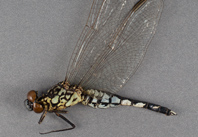Abstract
Five new species of the genus Tripylella are described, two from México, one from Fátima, Portugal, one from Quito, Ecuador, and one from California, USA. Tripylella mexicana sp. n. is characterized by its short body (average 0.74 mm), short pharynx (average 161 μm), short tail (average 117 μm), presence of an excretory pore and small setae distributed sparsely along the body, the presence of body pores, the posterior position of the subventral teeth in relation to the small dorsal tooth with all teeth in contiguous stomal chambers, the finely-striated cuticle with many anastomoses, the non-protruding vulval lips, and the presence of sclerotized pieces in the vulval region. Tripylella muscusi sp. n. is characterized by its body length (average 0.94 mm), pharynx length (average 201 μm), tail length (average 140 μm), the anterior position of the subventral teeth in relation to the small dorsal tooth in a single stomal chamber, the presence of an excretory pore, the presence of body pores and sparse somatic setae, the finely-striated cuticle with sparse anastomoses, protruding vulval lips and sclerotized oval-shaped pieces present in the vulval region. Tripylella quitoensis sp. n. is characterized by the short body length (average 0.72 mm), the short outer labial setae, the short pharynx (average 175 μm), the location of the anterior subventral teeth and posterior dorsal tooth in the same stomal chamber, the short tail (average 98 μm), the apparent absence of an excretory pore, presence of body pores, presence of somatic setae, a finely-striated cuticle, non-protruding vulval lips, and very small oval sclerotized pieces in the vulva. Tripylella fatimaensis sp. n. is characterized by the short body, (average 0.74 mm) long, by the length of the pharynx (average 180 μm), the length of the tail (average 110 μm) and in the length of its reduced diameter portion, 45–58 μm, the presence of an excretory pore, body pores and three pairs of caudal setae (one pair each latero-ventral, latero-dorsal and ventral). Tripylella dentata sp. n. is characterized, and differs from all the species of the genus, by the presence of two adjacent stomal chambers, with two large teeth, one dorsal and one ventral, in the posterior stomal chamber and two subventral teeth in the anterior smaller chamber, short body (average 0.85 mm), pharynx length (average 209 μm), tail length (average 115 μm), the apparent absence of an excretory pore, the presence of two cervical setae in a lateral position, and by the presence of conspicuous pores along the body.
References
Andrássy, I. (2008) Two new and a known species of the family Tripylidae (Nematoda: Enoplida) from the tropics. Opuscula Zoologica Budapest, 37, 3–9.
Andrássy, I. (2006) Three new species of the family Tripylidae (Penetrantia: Enoplida) from South America. International Journal of Nematology, 16, 208–216.
Andrássy, I. (2007) Free.living nematodes of Hungary (Nematoda, Errantia), II. Hungarian Natural History Museum, Budapest, 496 pp.
Barker, K.R. (1985) Nematode extraction and bioassays. In Barker, K.R., Carter, C.C. & Sasser, J.N. (Eds.), An Advanced Treatise on Meloidogyne. Vol. II. Methodology. North Carolina State University Graphics, Raleigh, North Carolina, pp. 19–25.
Bastian, H.C. (1865) Monograph of the Anguillulidae, or free nematoids, marine, land, and freshwater, with descriptions of 100 new species. Transactions of the Linnean Society of London, 25, 73–184.
http://dx.doi.org/10.1111/j.1096-3642.1865.tb00179.xBrzeski, M.W. & Winiszewska-Ślipińska, G. (1993) Taxonomy of Tripylidae (Nematoda: Enoplia). Nematologica, 39, 12–52.
http://dx.doi.org/10.1163/187529293X00024Brzeski, M.W. (1963) Nematode genera of the family Tripylidae (Nematoda, Enoplida). Acta Zoological Cracoviensia, 8, 295–308.
Bütschli, O. (1873) Beiträge zur Kenntnis der freilebenden Nematoden. Nova Acta Academiae Caesareae Leopoldino.Carolinae Germanicae Naturae Curiosorum, 36, 1–144.
Cid del Prado-Vera, I., Ferris, H. & Nadler, S.A. (2016) Five new species of the family Tripylidae (Nematoda: Enoplida) from North and Central America, with keys to the species of Trischistoma and Tripylina. Zootaxa, 4109 (2), 173–197.
http://doi.org/10.11646/zootaxa.4109.2.4
Cid del Prado-Vera, I., Ferris, H. & Nadler, S.A. (2010) Soil inhabiting nematodes of the genera Trischistoma, Tripylina and Tripyla from México and the USA with descriptions of new species. Journal of Nematode Morphology and Systematics, 13, 29–49.
Cid del Prado-Vera, I., Ferris, H., Nadler, S.A. & Lamothe Argumedo, R. (2012) Four new species of Tripylina Brzeski, 1963 (Enoplida: Tripylidae) from México, with an emended diagnosis of the genus. Journal of Nematode Morphology and Systematics, 15, 71–86.
De Maeseneer, J. & d’Herde, J. (1963) Méthodes utilisées pour l’étude des anguillules libres du sol. Revue d’Agriculture, 16, 441–447.
Holterman, M., van der Wurff, A., van den Elsen, S., van Megen, H., Bongers, T., Holovachov, O., Bakker, J. & Helder, J. (2006) Phylum-wide analysis of SSU rDNA reveals deep phylogenetic relationships among nematodes and accelerated evolution toward crown clades. Molecular Biology and Evolution, 23, 1792–1800.
http://dx.doi.org/10.1093/molbev/msl044Loytynoja, A. & Milinkovitch, M.C. (2003) A hidden Markov model for progressive multiple alignment. Bioinformatics, 19, 1505–1513.
http://dx.doi.org/10.1093/bioinformatics/btg193Miller, M.A., Pfeiffer, W. & Schwartz, T. (2010) Creating the CIPRES Science Gateway for inference of large phylogenetic trees. In: Proceedings of the Gateway Computing Environments Workshop (GCE), 14 November 2010, New Orleans, LA, pp 1–8.
http://dx.doi.org/10.1109/GCE.2010.5676129Nylander, J.A.A. (2004) MrModeltest v2. Program distributed by the author. Evolutionary Biology Centre, Uppsala University, Sweden.
Ronquist, F. & Huelsenbeck, J.P. (2003) MrBayes 3: Bayesian phylogenetic inference under mixed models. Bioinformatics, 19, 1572–1574.
http://dx.doi.org/10.1093/bioinformatics/btg180Seinhorst, J.W. (1959) A rapid method for the transfer of nematodes from fixative to anhydrous glycerin. Nematologica, 4, 67–69.
http://dx.doi.org/10.1163/187529259X00381van Megen, H., van den Elsen, S., Holterman, M., Karssen, G., Mooyman, P., Bongers, T., Holovachov, A., Bakker, J. & Helder, J. (2009) A phylogenetic tree of nematodes based on about 1200 full.length small subunit ribosomal DNA sequences. Nematology, 11, 927–950.
http://dx.doi.org/10.1163/156854109X456862Zhao, Z.Q. (2009) A review of the genus Tripylina Brzeski, 1963 (Nematoda: Triplonchida), with descriptions of five new species from New Zealand. Zootaxa 2238, 1–24.
Zhao, Z.Q., Xi, T.Y. & Xu, Y.M. (2014) A new species of the genus Tripylella Brzeski & Winiszewska.Ślipińska, 1993 (Nematoda: Triplonchida: Tripylidae) from New Zealand. Transactions of the Royal Society of South Australia, 138, 267–276.
http://dx.doi.org/10.1080/03721426.2014.11649014

